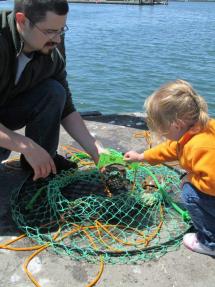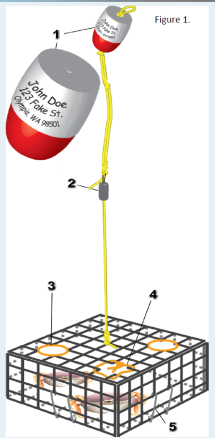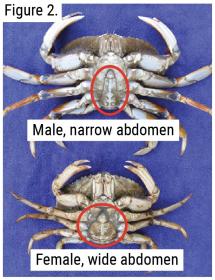For current regulations, see our crab seasons and areas webpage.
Report illegal activity with as much detail as possible as soon as it occurs. Call 1-877-933-9847 or submit a report to WDFW Police at: wdfw.wa.gov/about/enforcement/report
Download or print our Crabbing on the Coast brochure (PDF), or review the information below.

Know before you go
- Know the difference between male and female crabs. Only male Dungeness crabs can be kept.
- Know how to measure the male crabs.
- Know the types of crabs and how to identify them. Different rules apply to Dungeness crab and red rock crab.
- Know how to identify soft-shell crabs; learn more on this webpage.
- Make sure your traps and gear meet all the requirements in the regulation pamphlet for the area you will be crabbing.
Methods of harvesting
Crabs can be harvested in a variety of ways:
- Wading with a dip net or dip rake on coastal beaches
- With devices cast from a fishing pole
- By hand using scuba gear
- With pots that catch and hold crab
- With ring nets and star traps that allow crab to enter and exit freely
Any method which involves piercing the crab shell, poisons, or chemical irritants is illegal. Public fishing piers offer opportunity for Dungeness crab for those without a boat.
Using a boat will allow access to many of the most productive crab waters along the coast. It is illegal to pull gear that has a buoy with someone else’s name on it. Setting or retrieving gear from a boat is illegal from one hour after sunset to one hour before sunrise.
Preparing traps, buoys, and lines
Recreational crab traps and ring nets come in a variety of designs. The regulation pamphlet details the requirements of crab pots.
Check your traps to be sure there are no large holes in the mesh, tunnel entrance gates swing freely, and the escape cord has not already deteriorated.
Each unattended pot or ring net must be attached by a line to its own buoy. Each line must be durable and either sink in salt water (preferred) or be weighted so it does not float on the surface. Floating lines are often entangled in propellers and result in lost traps, unnecessary crab mortality, and propeller damage.
The buoy should be visible on the surface at all times, except during extreme tidal conditions. It must also be half red and half white in color. Buoys must be legibly marked with the fisher’s full name and current address. A phone number is optional, but recommended.
Figure 1:
- Properly marked buoy
- Line weight (if not sinking line)
- Escape ring 4 1/4" in diameter and 4" in Columbia River area (two required)
- Escape cord (removal leaves a 3" by 5" opening)
- Entrance gate
* Flags and staffs on buoys are optional. These are often used to visually identify your trap from a distance.

Time of day
Slack water (the time around high or low tide) is the best time to crab.
During slack water, crabs are generally walking around and foraging since they are not getting pushed around by tidal exchange.
Baiting and deploying traps
Traps and ring nets can be baited with an assortment of baits. The best baits include fish carcasses, clams, and squid. Baits that are commonly used and widely available include chicken and turkey. Use bait containers that allow some access to the bait and allow water to flow around it to carry off scent. Try to place baits in the trap so that crab must enter to feed.
Be smart and prevent the loss of your traps and the corresponding waste of crabs. Lost traps will continue to “ghost fish” because captured crabs die and act as bait for new victims.
- Do not set traps in areas with extreme currents or heavy boat and/or barge traffic.
- Add 5 to 10 pounds of weight to lighter traps so they are not swept off by currents.
- Use lines of correct length and know your water depth. Allow for tide height variation and extra scope.
- Use proper sinking lines and buoys. Use extra buoys in extreme currents.
- Whenever possible, mark your traps with GPS so they can be easily found.
- Working your gear will add to success.
Working your gear
- Tie the end of your crab line to the dock or pier before you throw it in the water.
- If using a pot, allow one to two hours before retrieving your gear.
- When crabbing with rings, allow 15 to 30 minutes before retrieving your gear. Remember to retrieve at a brisk and consistent speed in order to retain the crabs within the ring.
Cleaning and cooking
Crabs may be cleaned before or after cooking. For the cleanest and safest product, the Washington Department of Health advises to kill and clean your crab before cooking.
To clean crabs in the field, you must keep the shell to prove the crab was legal to harvest. Kill the crab with a sharp blow to the middle of its underside with a cleaver or similar object. Pull the top shell off from the back toward the front. Break the crab into two parts down the midline. Remove the viscera, mouth-parts, tail, and gills. Rinse the body if desired.
Boil crabs in salt water (3 to 5 ounces of salt per gallon). Cook for a total of 12 to 15 minutes, with at least three of those minutes being after the water returns to a rolling boil. After cooking, immerse them in cold water for about two minutes to stop the cooking process and loosen the meat from the shell.
Capturing, measuring, and sorting
Crabs must be sorted and all undersized males, soft-shell crabs, and female Dungeness crabs must be released immediately back to the water. It is also illegal to keep only the claws of crabs.

Female crabs can be identified by their wider abdominal flap as shown in Figure 2.
To measure male crabs, use a crab caliper available from most sporting goods vendors. Measure the distance inside the points as shown in the below image. Do not measure to the tips of the points.

The minimum size for male Dungeness crabs is 6 inches in the Pacific Ocean, including Willapa Bay and Grays Harbor, and 5 3/4" in the Columbia River. Estimating or using rulers and/or dollar bills is unwise and could result in possession of undersize crab and a fine.
When releasing crab, take care to gently place them back to the water. If crabbing from a pier, this may require lowering them down with a bucket and line.